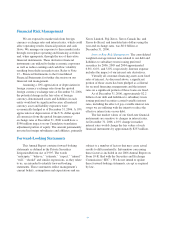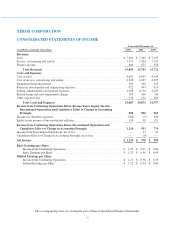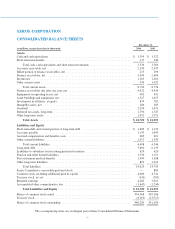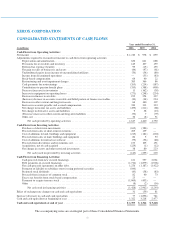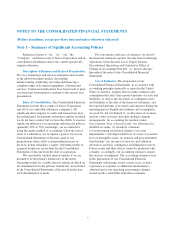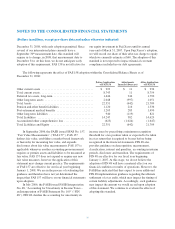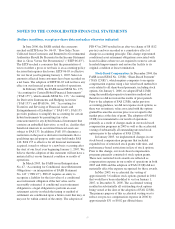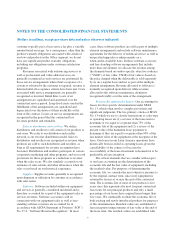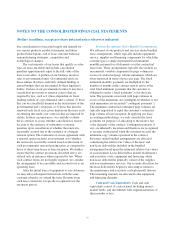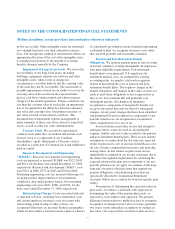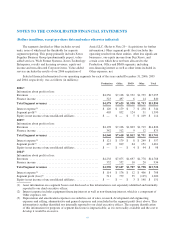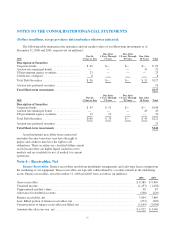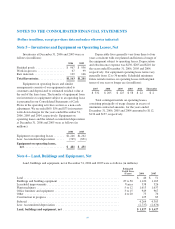Xerox 2006 Annual Report Download - page 61
Download and view the complete annual report
Please find page 61 of the 2006 Xerox annual report below. You can navigate through the pages in the report by either clicking on the pages listed below, or by using the keyword search tool below to find specific information within the annual report.NOTES TO THE CONSOLIDATED FINANCIAL STATEMENTS
(Dollars in millions, except per-share data and unless otherwise indicated)
customer typically pays a base service fee plus a variable
amount based on usage. As a consequence, other than the
product warranty obligations associated with certain of
our low end products in the Office segment, we do not
have any significant product warranty obligations,
including any obligations under customer satisfaction
programs.
Revenues associated with outsourcing services as
well as professional and value-added services are
generally recognized as such services are performed. In
those service arrangements where final acceptance of a
system or solution by the customer is required, revenue is
deferred until all acceptance criteria have been met. Costs
associated with service arrangements are generally
recognized as incurred. Initial direct costs of an
arrangement are capitalized and amortized over the
contractual service period. Long-lived assets used in the
fulfillment of the arrangements are capitalized and
depreciated over the shorter of their useful life or the
term of the contract. Losses on service arrangements are
recognized in the period that the contractual loss
becomes probable and estimable.
Sales to distributors and resellers: We utilize
distributors and resellers to sell certain of our products to
end-users. We refer to our distributor and reseller
network as our two-tier distribution model. Sales to
distributors and resellers are recognized as revenue when
products are sold to such distributors and resellers, as
long as all requirements for revenue recognition have
been met. Distributors and resellers participate in various
cooperative marketing and other programs, and we record
provisions for these programs as a reduction to revenue
when the sales occur. We also similarly account for our
estimates of sales returns and other allowances when the
sales occur based on our historical experience.
Supplies: Supplies revenue generally is recognized
upon shipment or utilization by customer in accordance
with sales terms.
Software: Software included within our equipment
and services is generally considered incidental and is
therefore accounted for as part of the equipment sales or
services revenues. Software accessories sold in
connection with our equipment sales as well as free-
standing software revenues are accounted for in
accordance with AICPA Statement of Position (“SOP”)
No. 97-2, “Software Revenue Recognition.” In most
cases, these software products are sold as part of multiple
element arrangements and include software maintenance
agreements for the delivery of technical service as well as
unspecified upgrades or enhancements on a
when-and-if-available basis. In those software accessory
and free-standing software arrangements that include
more than one element, we allocate the revenue among
the elements based on vendor-specific objective evidence
(“VSOE”) of fair value. VSOE of fair value is based on
the price charged when the deliverable is sold separately
by us on a regular basis and not as part of the multiple-
element arrangement. Revenue allocated to software is
normally recognized upon delivery while revenue
allocated to the software maintenance element is
recognized ratably over the term of the arrangement.
Revenue Recognition for Leases: Our accounting for
leases involves specific determinations under SFAS
No. 13, which often involve complex provisions and
significant judgments. The two primary criteria of SFAS
No. 13 which we use to classify transactions as sales-type
or operating leases are (1) a review of the lease term to
determine if it is equal to or greater than 75% of the
economic life of the equipment and (2) a review of the
present value of the minimum lease payments to
determine if they are equal to or greater than 90% of the
fair market value of the equipment at the inception of the
lease. Our leases in our Latin America operations have
historically been recorded as operating leases given the
cancellability of the contract or because the
recoverability of the lease investment is deemed not to be
predictable at lease inception.
The critical elements that we consider with respect
to our lease accounting are the determination of the
economic life and the fair value of equipment, including
the residual value. For purposes of determining the
economic life, we consider the most objective measure to
be the original contract term, since most equipment is
returned by lessees at or near the end of the contracted
term. The economic life of most of our products is five
years since this represents the most frequent contractual
lease term for our principal products and only a small
percentage of our leases have original terms longer than
five years. We continually evaluate the economic life of
both existing and newly introduced products for purposes
of this determination. Residual values are established at
lease inception using estimates of fair value at the end of
the lease term. Our residual values are established with
59


